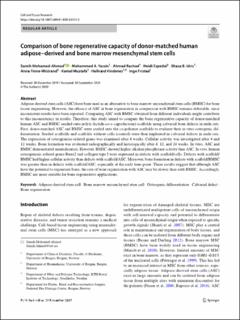| dc.contributor.author | Mohamed Ahmed, Samih | |
| dc.contributor.author | Yassin, Mohammed Ahmed | |
| dc.contributor.author | Elsebahy, Ahmad Rashad Saad Mohamed | |
| dc.contributor.author | Espedal, Heidi | |
| dc.contributor.author | Idris, Shaza Bushra M. | |
| dc.contributor.author | Finne-Wistrand, Anna | |
| dc.contributor.author | Vindenes, Hallvard | |
| dc.contributor.author | Mustafa, Kamal Babikeir Eln | |
| dc.contributor.author | Fristad, Inge | |
| dc.date.accessioned | 2021-02-16T14:19:54Z | |
| dc.date.available | 2021-02-16T14:19:54Z | |
| dc.date.created | 2020-12-17T13:05:03Z | |
| dc.date.issued | 2020-11 | |
| dc.identifier.issn | 0302-766X | |
| dc.identifier.uri | https://hdl.handle.net/11250/2728472 | |
| dc.description.abstract | Adipose-derived stem cells (ASC) have been used as an alternative to bone marrow mesenchymal stem cells (BMSC) for bone tissue engineering. However, the efficacy of ASC in bone regeneration in comparison with BMSC remains debatable, since inconsistent results have been reported. Comparing ASC with BMSC obtained from different individuals might contribute to this inconsistency in results. Therefore, this study aimed to compare the bone regenerative capacity of donor-matched human ASC and BMSC seeded onto poly(L-lactide-co-ε-caprolactone) scaffolds using calvarial bone defects in nude rats. First, donor-matched ASC and BMSC were seeded onto the co-polymer scaffolds to evaluate their in vitro osteogenic differentiation. Seeded scaffolds and scaffolds without cells (control) were then implanted in calvarial defects in nude rats. The expression of osteogenesis-related genes was examined after 4 weeks. Cellular activity was investigated after 4 and 12 weeks. Bone formation was evaluated radiographically and histologically after 4, 12, and 24 weeks. In vitro, ASC and BMSC demonstrated mineralization. However, BMSC showed higher alkaline phosphatase activity than ASC. In vivo, human osteogenesis–related genes Runx2 and collagen type I were expressed in defects with scaffold/cells. Defects with scaffold/BMSC had higher cellular activity than defects with scaffold/ASC. Moreover, bone formation in defects with scaffold/BMSC was greater than in defects with scaffold/ASC, especially at the early time-point. These results suggest that although ASC have the potential to regenerate bone, the rate of bone regeneration with ASC may be slower than with BMSC. Accordingly, BMSC are more suitable for bone regenerative applications. | en_US |
| dc.language.iso | eng | en_US |
| dc.publisher | Springer | en_US |
| dc.rights | Navngivelse 4.0 Internasjonal | * |
| dc.rights.uri | http://creativecommons.org/licenses/by/4.0/deed.no | * |
| dc.title | Comparison of bone regenerative capacity of donor-matched human adipose–derived and bone marrow mesenchymal stem cells | en_US |
| dc.type | Journal article | en_US |
| dc.type | Peer reviewed | en_US |
| dc.description.version | publishedVersion | en_US |
| dc.rights.holder | Copyright The Author(s) | en_US |
| cristin.ispublished | true | |
| cristin.fulltext | original | |
| cristin.qualitycode | 1 | |
| dc.identifier.doi | 10.1007/s00441-020-03315-5 | |
| dc.identifier.cristin | 1861069 | |
| dc.source.journal | Cell and Tissue Research | en_US |
| dc.source.pagenumber | 1-15 | en_US |
| dc.identifier.citation | Cell and Tissue Research, 2020. | en_US |

